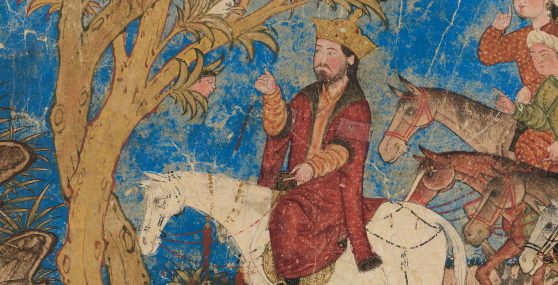September 21, 2024–January 12, 2025
-
Dates
-
Location
Arthur M. Sackler Gallery | Galleries 23 and 24
-
Collection Area
Arts of the Islamic World
At A Glance
This exhibition focuses on a single copy of the Shahnama made around 1330 in Iran, not on the literary work completed by the Persian poet Firdawsi three hundred years earlier around the year 1010.
Monumental in size and boldly illustrated, the Great Mongol Shahnama is one of the most celebrated of all medieval Persian manuscripts. Considered Iran’s national epic, the Shahnama (Book of kings) was completed by the poet Firdawsi around 1010. The copy known as the Great Mongol Shahnama was made three hundred years later, likely commissioned by Abu Sa‘id of the Ilkhanid dynasty, a branch of the Mongol Empire that ruled over Iran and West Asia. Between the manuscript’s covers, art, power, and history intertwined.
The Shahnama recounts the story of Iran from the beginning of time through the fall of the Sasanian dynasty in the seventh century. The illustrations in the Great Mongol Shahnama emphasize historical kings of Iran’s past, including Alexander the Great, known in Persian as Iskandar, and the pre-Islamic Sasanian monarchs, such as Ardashir I, Bahram Gur (Bahram V), and Kasra Anushirvan (Khusraw I Anushirvan). These figures served as role models to the Ilkhanid rulers, and the manuscript’s impressive paintings demonstrate how the Ilkhanids inserted themselves into Iran’s history.
An Epic of Kings offers a once-in-a-lifetime opportunity to see twenty-five folios from this now dismantled manuscript. It is also the first exhibition to present paintings from the Great Mongol Shahnama alongside contemporaneous works from China, the Mediterranean, and the Latin West. Experience this unique historical moment of cultural exchange across Eurasia—where commodities, people, and ideas circulated like never before—with Iran at its center.
Explore this Exhibition
Folios in NMAA’s Collections
Divided into two volumes, the Great Mongol Shahnama may have originally comprised about 380 folios and over two hundred paintings, but the colossal project was never completed. The manuscript was removed from Iran under obscure circumstances in the early twentieth century. Around 1910, the Belgian art dealer Georges-Joseph Demotte bought the manuscript in Paris from an Armenian dealer. Demotte dismantled the Great Mongol Shahnama and sold its leaves individually. As a result of Demotte’s tragic intervention, the full manuscript was forever lost, and its surviving illustrated folios severely damaged.
The National Museum of Asian Art purchased six folios between 1923 and 1942. In 1986, the Smithsonian acquired the celebrated collection of the French jeweler Henri Vever, which included eight additional paintings from the manuscript. Today, NMAA houses the largest number of folios from the Great Mongol Shahnama in the world. The fourteen folios in the museum’s collections are presented here in order of appearance within the Shahnama’s text.

Early in the Shahnama, the Arab prince Zahhak kills his father, usurps the throne, invades Iran, and reigns for over a thousand years. Here, the evil king sits on the throne in a crowded audience hall, where a feeling of dread is palpable. But what a cosmopolitan vibe! The variety of fabrics used for the hangings, costumes, turbans, Mongol headgear, Anatolian carpets, and Chinese furniture all testify to the richness of the land Zahhak has just captured and, by extension, the sophistication of the Ilkhanid court.
Zahhak enthroned
Folio from the Great Mongol Shahnama
Iran, probably Tabriz, ca. 1330
Opaque watercolor, ink, and gold on paper
Freer Gallery of Art Collection
Purchase—Charles Lang Freer Endowment F1923.5
Image 1 of 14
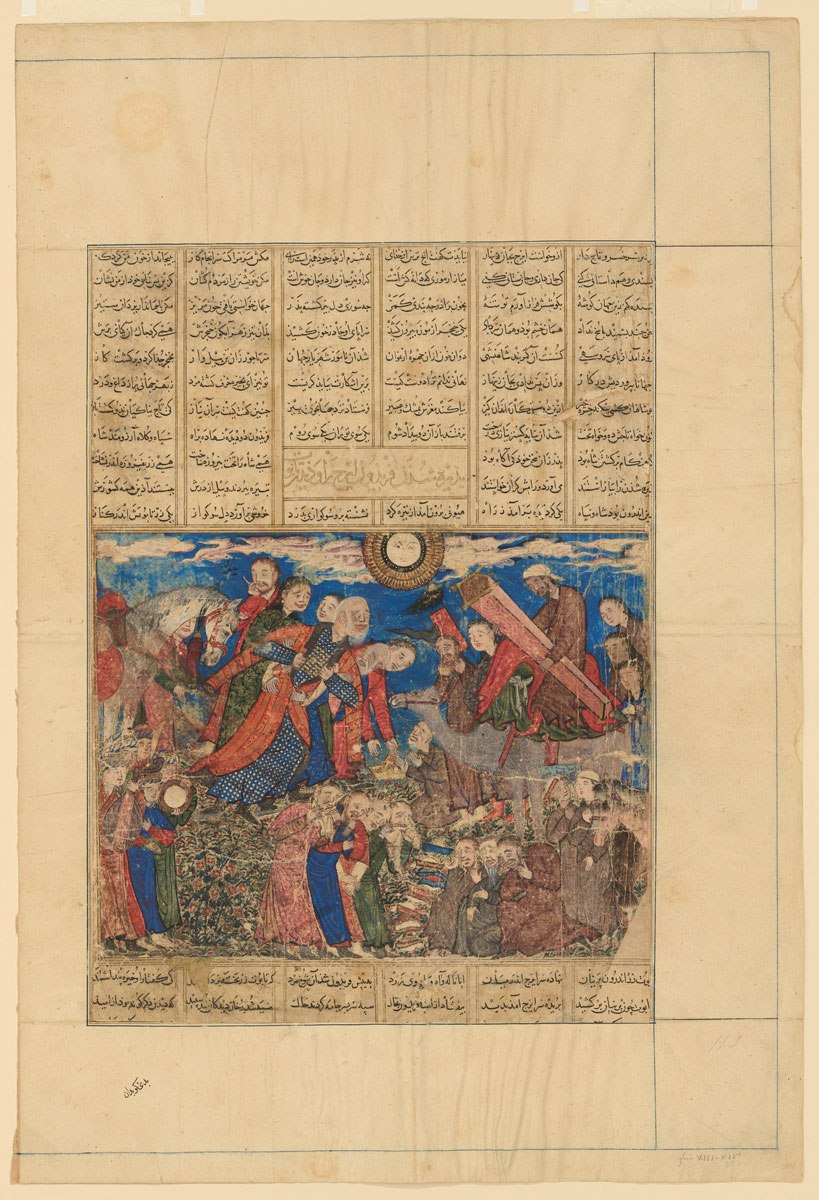
Mythical king Faridun, who dethroned the tyrant Zahhak, prepares to welcome his son Iraj home from a voyage when instead he sees his son’s casket amid a procession. He learns that Iraj’s two brothers have murdered him out of jealousy. Seeing the coffin, the king falls from his horse, his crown on the floor. The pallor of the faces, the mournful expressions, and the somber hues emphasize the tragedy of the scene. The subject of this episode recalls a similar event in the life of Hülegü, the founder of the Ilkhanid dynasty, when he heard about his son Jumaqur’s death while riding to see him.
Faridun collapses on seeing Iraj’s coffin
Folio from the Great Mongol Shahnama
Iran, probably Tabriz, Ilkhanid dynasty, ca. 1330
Ink, color, and gold on paper
Arthur M. Sackler Collection
Purchase—Smithsonian Unrestricted Trust Funds, Smithsonian Collections Acquisition Program, and Dr. Arthur M. Sackler S1986.101
Image 2 of 14
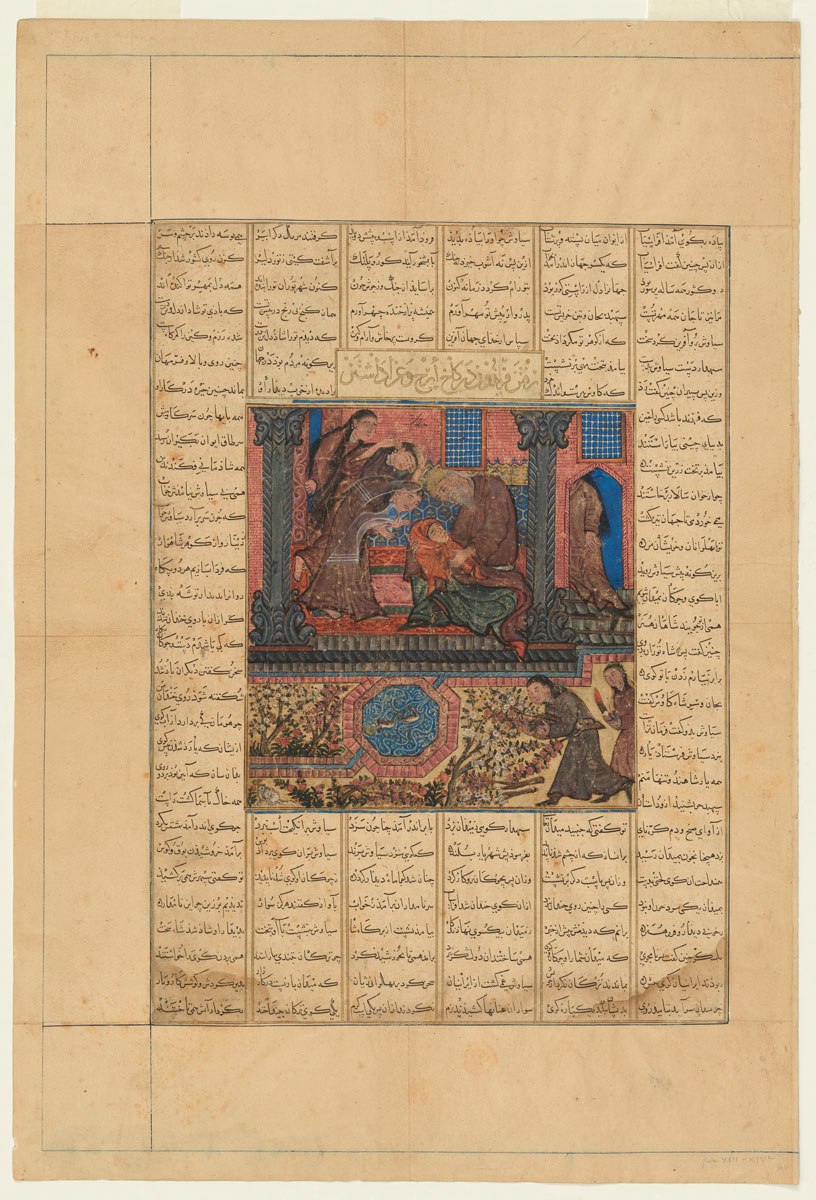
Faridun takes Iraj’s head to his son’s palace and sits in the garden of the pavilion, which he orders burned down and destroyed because it reminds him too much of his beloved departed child. The destruction occurs in the foreground as the seated father bows in mourning over Iraj’s severed head, which rests on his lap. The tragic episode may relate to Ilkhanid Sultan Uljaytu (reigned 1304–17), the father of Great Mongol Shahnama patron Abu Sa‘id, who lost five of his six sons when they were young.
Faridun mourns Iraj
Folio from the Great Mongol Shahnama
Iran, probably Tabriz, Ilkhanid dynasty, ca. 1330
Ink, color, and gold on paper
Arthur M. Sackler Collection
Purchase—Smithsonian Unrestricted Trust Funds, Smithsonian Collections Acquisition Program, and Dr. Arthur M. Sackler S1986.100
Image 3 of 14

During the reign of Manuchehr, Iraj’s grandson, Rudaba, the daughter of the king of Kabul, falls in love with Zal, a great warrior and Iran’s champion. She uses her maid as a messenger to her beloved. When her mother, Sindukht, uncovers the secret liaison by intercepting the servant, who is kneeling in front of her in this painting, Rudaba must explain the situation. In the Ilkhanid period, elite women were politically and socially powerful and often sought opportunities to manipulate politics. They strived to place their son on the throne or their daughter as a royal wife.
Sindukht reproves Rudaba
Folio from the Great Mongol Shahnama
Iran, probably Tabriz, Ilkhanid dynasty, ca. 1330
Opaque watercolor, ink, and gold on paper
Arthur M. Sackler Collection
Purchase—Smithsonian Unrestricted Trust Funds, Smithsonian Collections Acquisition Program, and Dr. Arthur M. Sackler S1986.102a–d
Image 4 of 14

Zav, the son of Tahmasp and a distant descendant of King Faridun, accedes to the throne of Iran at an advanced age and only reigns for five years before he dies. Here, the painting features all the pageantry of a coronation, and Zav is depicted crowned atop the throne, holding a wine cup. Scholars have suggested an association with Sultan Gaykhatu (reigned 1292–95), who only reigned a few years and who was a notorious wine drinker, which explains the presence of the cup bearer in the foreground. This is the only time a cup bearer appears in a painting from the Great Mongol Shahnama.
Shah Zav enthroned
Folio from the Great Mongol Shahnama
Iran, probably Tabriz, Ilkhanid dynasty, ca. 1330
Opaque watercolor, ink, and gold on paper
Arthur M. Sackler Collection
Purchase—Smithsonian Unrestricted Trust Funds, Smithsonian Collections Acquisition Program, and Dr. Arthur M. Sackler S1986.107
Image 5 of 14

Episodes about legitimacy and royal authority were favored subjects for illustrations in the Great Mongol Shahnama. The infant prince Darab is cast away on an ark by his mother, Humay, who plans to seize power after the death of her husband, Bahman. Rescued by a launderer, Darab is raised unaware of his royal ancestry. Much later, while fighting a battle, Darab takes refuge in a vault. As Humay’s general, Rashnavad, passes nearby, a voice tells him the sleeping youth inside the vault is the rightful king of Iran.
Darab sleeping in the vault
Folio from the Great Mongol Shahnama
Iran, probably Tabriz, Ilkhanid dynasty, ca. 1330
Opaque watercolor, ink, and gold on paper
Freer Gallery of Art Collection
Purchase—Charles Lang Freer Endowment F1930.78
Image 6 of 14

The Shahnama exalts Alexander the Great (356–323 BCE) under his Persian identity of Iskandar. For the Iranians and the Ilkhanids, he is known as the World Conqueror. More than any other monarch, Iskandar personifies the warrior king, the skillful peacemaker, and the formidable judge.
In this folio, after fighting and killing King Fur in India, Iskandar visits Mecca en route to Andalusia. There, he meets Taynush, Fur’s son-in-law, who eventually submits to him. Afterward, Iskandar returns to India to consult with the Brahmans on the meaning of life. The wise men caution him about the dangers of greed in his attempt to conquer the world.
Taynush before Iskandar and the visit to the Brahmans
Folio from the Great Mongol Shahnama
Iran, probably Tabriz, Ilkhanid dynasty, ca. 1330
Ink, color, and gold on paper
Arthur M. Sackler Collection
Purchase—Smithsonian Unrestricted Trust Funds, Smithsonian Collections Acquisition Program, and Dr. Arthur M. Sackler S1986.105.1
Image 7 of 14

Before his encounter with the talking tree, Iskandar gathers craftsmen from around the world to erect two gigantic walls made of iron, copper, and sulfur to protect the desperate local population from the beastly peoples of Gog and Magog. The artist focuses on the active construction of the wall, depicting blacksmiths and masons laboring as Iskandar oversees the work’s progress. Despite their association with destruction, the Mongols were also formidable patrons of architectural projects, which included massive religious buildings and military constructions throughout their dominion.
Iskandar building the wall against the peoples of Gog and Magog
Folio from the Great Mongol Shahnama
Iran, probably Tabriz, Ilkhanid dynasty, ca. 1330
Ink, color, and gold on paper
Arthur M. Sackler Collection
Purchase—Smithsonian Unrestricted Trust Funds, Smithsonian Collections Acquisition Program, and Dr. Arthur M. Sackler S1986.104
Image 8 of 14
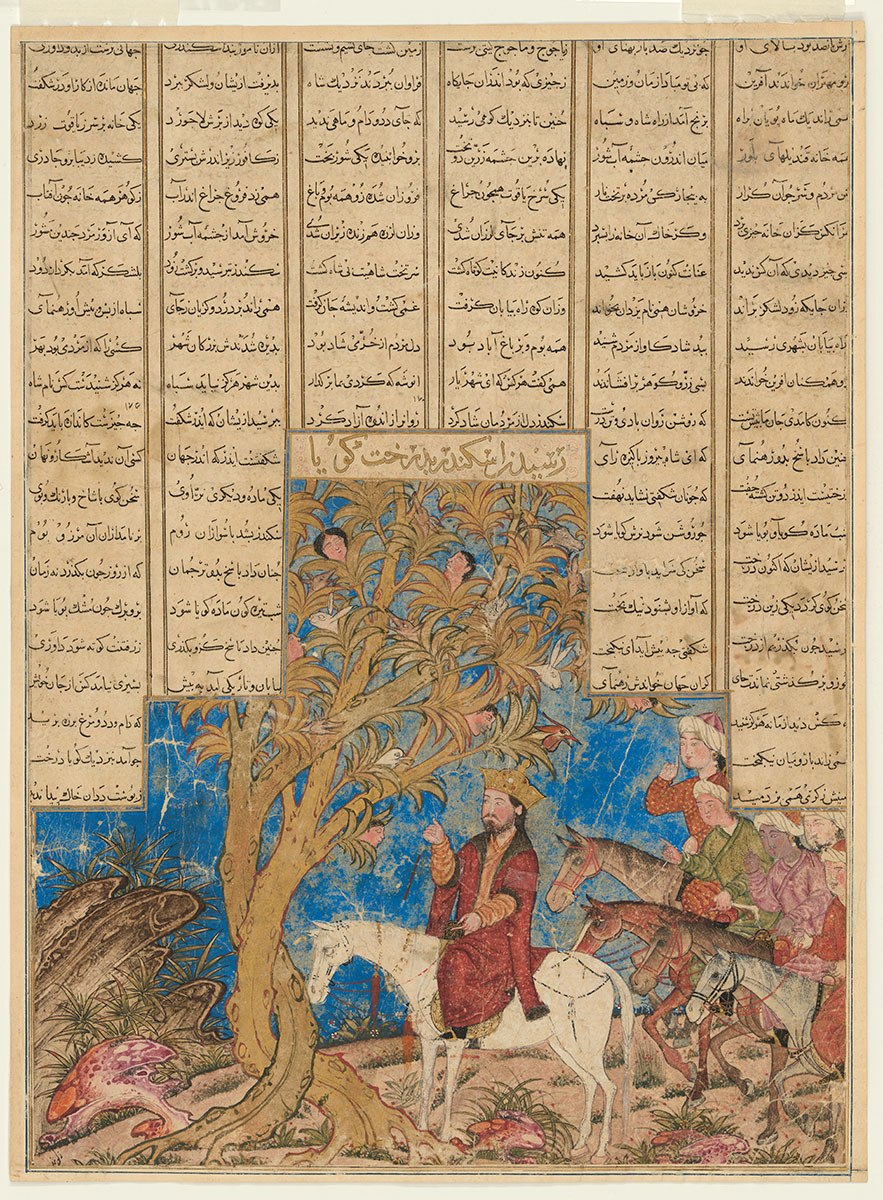
At the edge of the world, Iskandar comes upon a wondrous tree with two trunks, one male, which speaks in the daytime, and the other female, which speaks at night. While Iskandar is waiting to hear both, the female part warns him of his imminent death, despite his immeasurable power and wealth. To create the scene’s eeriness, the artist included fantastic elements, such as fungus-like rocks inspired by Chinese models. This scene may have resonated with the Ilkhanids, as some of them still maintained their shamanistic traditions and practices, including visits to sacred trees.
Iskandar and the talking tree
Folio from the Great Mongol Shahnama
Iran, probably Tabriz, Ilkhanid dynasty, ca. 1330
Ink, color, and gold on paper
Freer Gallery of Art Collection
Purchase—Charles Lang Freer Endowment F1935.23
Image 9 of 14

According to Firdawsi, Iskandar is buried on the open plain near Alexandria in Egypt. In the Great Mongol Shahnama, his bier is depicted in an elaborately furnished indoor setting. As Aristotle leans over the coffin of his disciple, Iskandar’s mother has thrown herself on her son’s casket in a poignant gesture of sorrow. Standing in a semicircle, mourners weep, and women in the foreground pull their hair in anguish. The sumptuous interior may have been inspired by contemporary Ilkhanid architecture and especially by the monumental tombs of Muslim rulers, such as Uljaytu’s tomb in Sultaniyya, a city 250 miles west of Tehran.
The bier of Iskandar
Folio from the Great Mongol Shahnama
Iran, probably Tabriz, Ilkhanid dynasty, ca. 1330
Ink, color, and gold on paper
Freer Gallery of Art Collection
Purchase—Charles Lang Freer Endowment F1938.3
Image 10 of 14

In a struggle for the Persian throne, young Ardashir must fight the last Parthian monarch, Ardavan (reigned 213–224). After forty days of battle, Ardavan is defeated and taken prisoner in front of Ardashir, who sentences him to death. The dramatic painting captures the very moment when Ardashir, the founder of the Sasanian dynasty, looks down at the defeated old Ardavan, whom farr has abandoned. Legitimacy and the affirmation of royal authority were essential for the Great Mongol Shahnama’s patron, Abu Sa‘id, who had to fight constantly to keep his throne.
Ardavan captured by Ardashir
Folio from the Great Mongol Shahnama
Iran, probably Tabriz, Ilkhanid dynasty, ca. 1330
Ink, color, and gold on paper
Arthur M. Sackler Collection
Purchase—Smithsonian Unrestricted Trust Funds, Smithsonian Collections Acquisition Program, and Dr. Arthur M. Sackler S1986.103
Image 11 of 14
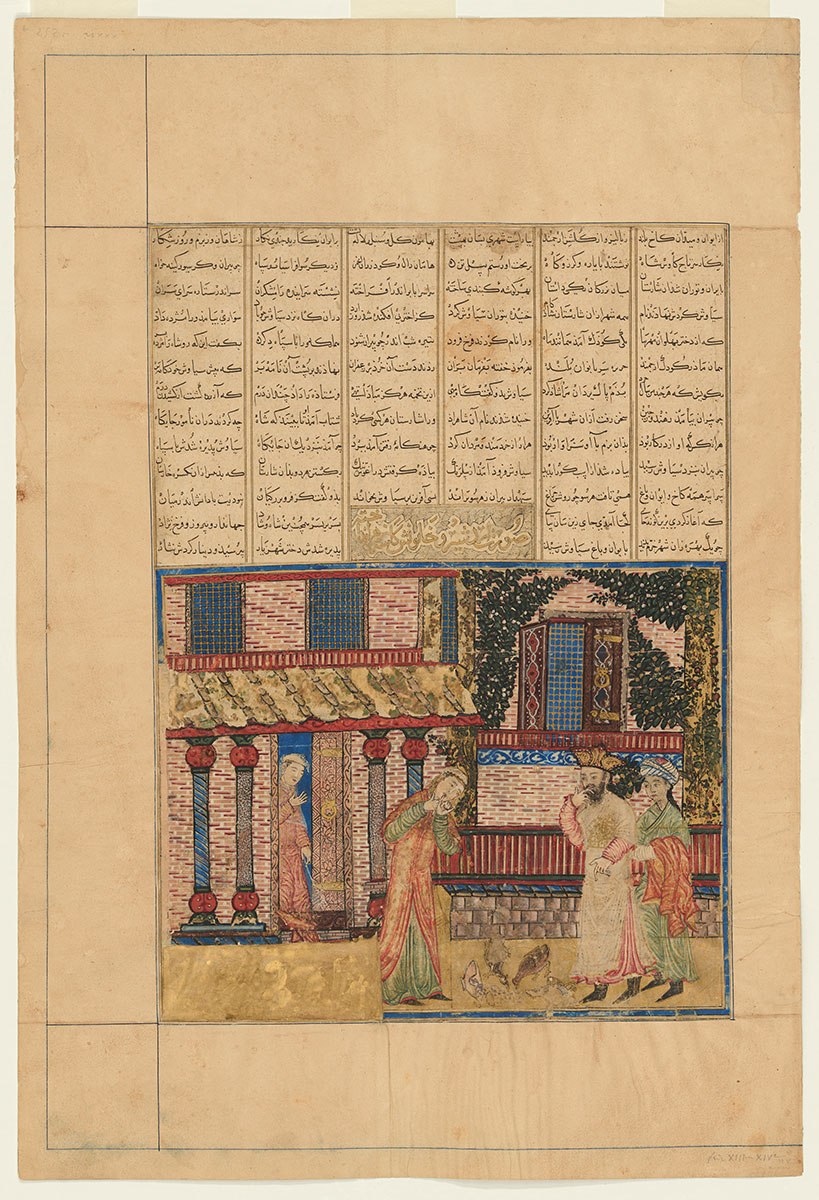
After executing Ardavan, the previous king, Ardashir marries the deceased ruler’s daughter. Seeking revenge for their father’s death, her brother Bahman provides her with poison. She presents it in a cup to Ardashir in the palace’s courtyard, but her hand shakes so much the cup falls and breaks on the floor. Suspicious, the king asks for four hens, all of which immediately die after ingesting the cup’s contents. This seldomly illustrated episode may have echoed a contemporaneous event during which Baghdad Khatun (died 1335), the wife of Abu Sa‘id, allegedly attempted to murder him.
Ardashir and his wife
Folio from the Great Mongol Shahnama
Iran, probably Tabriz, Ilkhanid dynasty, ca. 1330
Ink, color, and gold on paper Freer Collection
Arthur M. Sackler Collection
Purchase—Smithsonian Unrestricted Trust Funds, Smithsonian Collections Acquisition Program, and Dr. Arthur M. Sackler S1986.106
Image 12 of 14

The ruler Bahram Gur is told of a mysterious cave that emits howls. In fact, the site houses the treasure of Jamshid, the mythical king known for his justice and tolerance. The painting faithfully depicts the treasure as described by Firdawsi, with gold and bejeweled statues of buffaloes, lions, wild asses, pheasants, and peacocks. Instead of keeping it for himself, Bahram Gur distributes the treasure in its entirety among the poor, an act of generosity and charity that inspired the Mongol sultans to treat their subjects well.
Bahram Gur discovers Jamshid’s treasure
Folio from the Great Mongol Shahnama
Iran, probably Tabriz, ca. 1330
Opaque watercolor, ink, and gold on paper
Freer Gallery of Art Collection
Purchase—Charles Lang Freer Endowment F1935.24
Image 13 of 14

Holding the mandil, the handkerchief of the wellborn, Anushirvan wears an elaborate crown and has his hair pulled back. His portrayal recalls Sasanian models, such as those on silver plates, including the so-called Shapur plate in the museum’s collections. Royal majesty is associated with a subject’s loyalty, represented here by Anushirvan’s vizier, Buzurjmihr, who receives bags of money, demonstrating that exceptional competence is rewarded by the king’s generosity. The painting may relate to the Ilkhanid ruler Uljaytu and his vizier, Taj al-Din ‘Ali-Shah (died 1324), whom his successor and patron of the Great Mongol Shahnama, Abu Sa‘id, also appreciated.
Anushirvan bestowing largess upon Buzurjmihr
Folio from the Great Mongol Shahnama
Iran, probably Tabriz, Ilkhanid dynasty, ca. 1330
Ink, color, and gold, on paper
Freer Gallery of Art Collection
Purchase—Charles Lang Freer Endowment F1942.2
Image 14 of 14
Shedding Light on the Shahnama
This video highlights recent scientific analysis of the illustrations on the fourteen Great Mongol Shahnama folios in the National Museum of Asian Art’s collections. Scientists used different forms of light to learn more about the pigment composition of the paintings and the creative process of Persian artists in the 1330s. They also identified possible alterations that may have been made centuries later.
Video | "Shedding Light on the Shahnama" | View on YouTube
Related Publication
The Great Mongol Shahnama
Author List: Robert Hillenbrand
Publisher: Hali Publications Ltd; National Museum of Asian Art, Smithsonian Institution
Publication Date: January 31, 2023
The Great Mongol Shahnama is widely considered to be the definitive version of Firdausi’s epic poem, and the greatest of all Persian illustrated manuscripts. The paintings from this manuscript are held in private collections and institutions around the world, and have only been seen together in a single volume once since they were originally dispersed. This monograph reunites the paintings and reproduces them as 67 full-page, high quality color plates, alongside an analysis by leading scholar of Islamic art, Robert Hillenbrand. With newly commissioned photographs and insights into technical aspects of the paintings, The Great Mongol Shahnama is a comprehensive resource for those interested in Persian art and manuscripts.
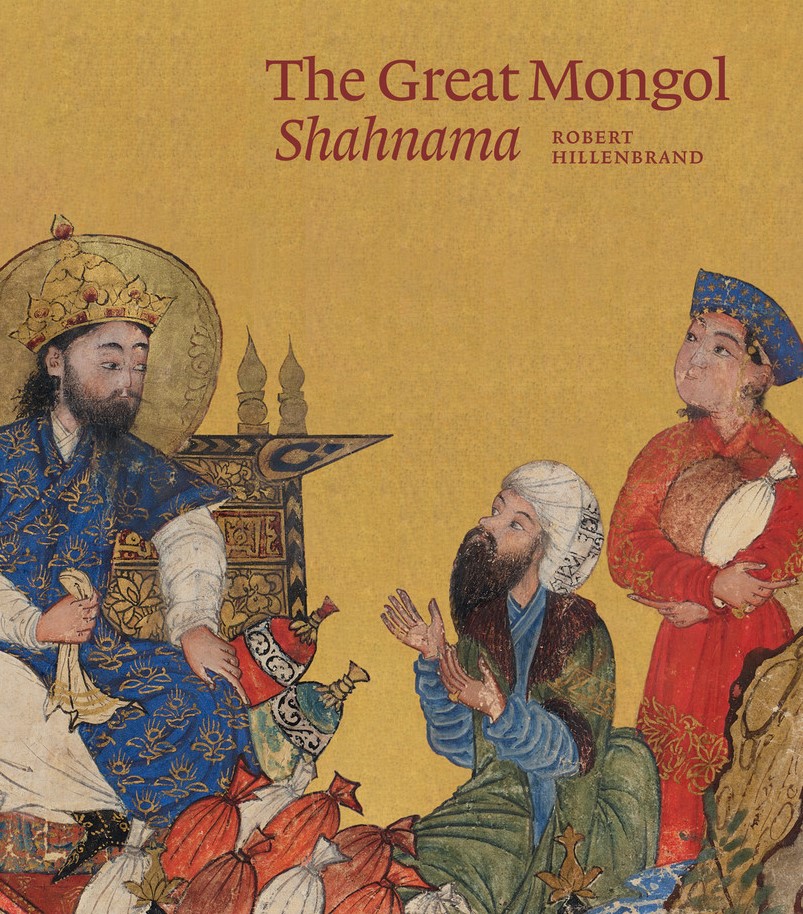
Support
Support for this exhibition is provided by The Ebrahimi Family Endowment for Persian, Arab, and Turkish Art; the Persian Art Programs Endowment; the Catherine and Ralph Benkaim Endowment; The Lee and Juliet Folger Fund; the Soudavar Memorial Foundation; and the Friends of the National Museum of Asian Art in honor of Marsha E. Swiss.
Related Exhibitions
-

The Shahnama: 1000 Years of the Persian Book of Kings
October 23, 2010–April 17, 2011
Iskandar and the talking tree (detail), folio from the Great Mongol Shahnama (Book of kings), Iran, probably Tabriz, Ilkhanid dynasty, ca. 1330, ink, color, and gold on paper, National Museum of Asian Art, Smithsonian Institution, Freer Collection, Purchase—Charles Lang Freer Endowment, F1935.23
- Jump To...


